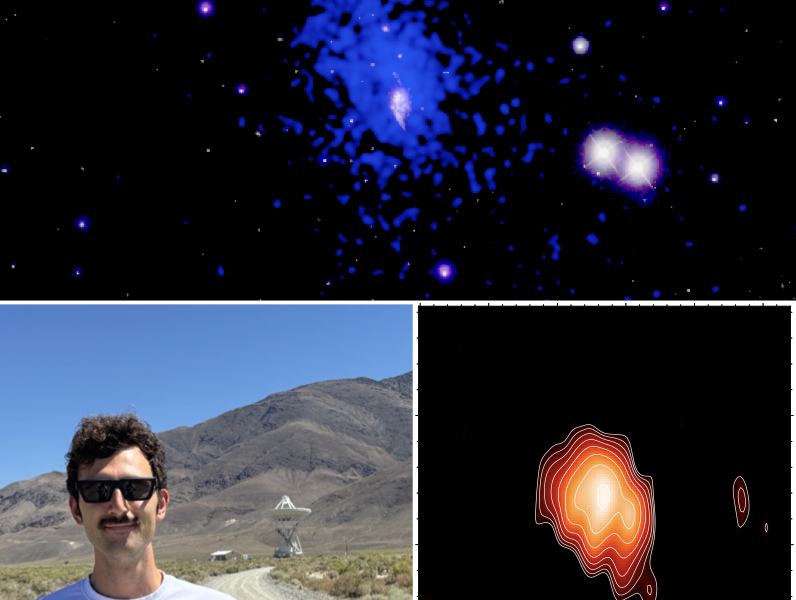The U.S. National Science Foundation National Radio Astronomy Observatory (NSF NRAO), in partnership with several leading Mexican universities and research institutes, has announced a series of landmark agreements and meetings aimed at advancing Mexico’s role in the Next Generation Very Large Array (ngVLA) project.
Recent News
Astronomers Discover a Superheated Star Factory in the Early Universe
Astronomers have uncovered a previously unknown, extreme kind of star factory by taking the temperature of a distant galaxy using the ALMA telescope. The galaxy is glowing intensely in superheated cosmic dust while forming stars 180 times faster than our own Milky Way.
Astronomers Share Largest Molecular Survey To-date: GOTHAM Legacy Data Goes Public
Astronomers in the “GBT Observations of TMC-1: Hunting Aromatic Molecules” research survey, known as GOTHAM, have released a spectral line survey with largest amount of telescope time ever conducted, charting more than 100 molecular species only found in deep space.
Astronomers Catch Supermassive Black Hole in the Act of ‘Waking Up’

NRAO Radio Telescopes Reveal Infant Jets from Recently Awakened Giant in Distant Galaxy Cluster
Astronomers using the U.S. National Science Foundation’s Very Long Baseline Array (NSF VLBA) and U.S. National Science Foundation’s Very Large Array (NSF VLA) have caught a supermassive black hole in the act of awakening from a long slumber, providing an unprecedented glimpse into the earliest stages of black hole activity. The discovery offers new insights into how these cosmic giants begin to influence their environments and could help solve longstanding puzzles about galaxy evolution.
The research, led by Francesco Ubertosi of the University of Bologna and the National Institute for Astrophysics in Italy (INAF/IRA), focused on the galaxy cluster CHIPS 1911+4455, located approximately 6 billion light-years from Earth. What makes this system extraordinary is that its central supermassive black hole has only recently “turned on” – astronomically speaking – beginning to actively consume material and launch jets just a thousand years ago.
“This is like watching a sleeping giant wake up,” said Ubertosi, the study’s lead author. “We’re seeing this supermassive black hole at the very beginning of its active phase, before it has had time to significantly alter its surroundings. It’s an incredibly rare opportunity to study the ‘before’ picture of black hole feedback.”
Using the NSF VLBA’s extraordinary resolution – capable of distinguishing details equivalent to reading a newspaper in Los Angeles from New York – the team discovered that the black hole’s jets extend only about 30 parsecs (roughly 100 light-years) from the central black hole. This may sound large, but in cosmic terms, these are infant jets. For comparison, mature black hole jets in similar systems can extend for tens of thousands of parsecs.
The NSF VLBA observations revealed a compact radio source with symmetric, two-sided jets emerging from the galaxy’s core. The radio spectrum shows the characteristic “peaked” shape that identifies this as a very young radio galaxy, estimated to be only about 1,000 years old – a cosmic blink of an eye.
“The jets are so young and small that they haven’t had time to push away the surrounding hot gas or disrupt the cooling process that’s happening in the cluster core,” explained co-author Myriam Gitti, also from the University of Bologna and INAF/IRA. “This gives us a unique laboratory to study how black hole feedback begins.”
Most studies of supermassive black holes in galaxy clusters focus on mature systems where the black hole has been active for millions of years, inflating enormous radio-emitting bubbles and heating the surrounding gas. CHIPS 1911+4455 represents what researchers call a “pre-feedback” cluster – a system where they can study the conditions that exist before the black hole significantly impacts its environment.
A previous study (Somboonpanyakul et al. 2021) had found that the hot gas in the cluster core has very low entropy and short cooling times. “We think what we’re seeing is the smoking gun of how supermassive black holes get triggered in the first place”, said co-author Pasquale Temi from the NASA Ames Research Center. “The gas in this cluster core is cooling very efficiently, potentially providing the fuel that awakened this sleeping black hole”.
While the central black hole is just beginning its activity, the galaxy surrounding it is already an exceptional star factory. The team’s analysis aligns with earlier investigations, suggesting that the galaxy is forming stars at a rate of 140-190 solar masses per year – more than 100 times faster than our own Milky Way galaxy. This makes it one of the most rapidly star-forming central cluster galaxies known.
Interestingly, the radio observations with the NSF VLA revealed extended “whiskers” of radio emission that align precisely with star-forming regions visible in Hubble Space Telescope images (originally presented in Somboonpanyakul et al. 2021). The whiskers seen in the NSF VLA images are likely powered by synchrotron radiation from supernovae and massive stars, providing independent confirmation of the galaxy’s prodigious star formation rate.
The discovery has important implications for understanding how supermassive black holes and their host galaxies co-evolve. Current theories suggest that black hole feedback is crucial for regulating star formation in massive galaxies, but most observations have been of systems where this process is already mature.
“CHIPS 1911+4455 may represent a different flavor of how black hole feedback gets started,” Ubertosi explained. “In this case, it’s not just the black hole being dormant for a long time that triggers cooling – the cluster also shows signs of a recent merger, which may have enhanced the cooling and helped wake up the black hole.”
The study required combining observations from multiple NSF NRAO facilities to achieve both the sensitivity and resolution needed to detect and characterize this young radio source. The NSF VLBA provided the ultra-high resolution needed to measure the tiny jets, while the NSF VLA offered the sensitivity required to detect the faint extended emission from star formation.
“This kind of discovery showcases the power of having multiple complementary radio telescopes,” said co-author Marcello Giroletti from the Italian National Institute for Astrophysics (INAF/IRA). “The NSF VLBA gives us the magnifying glass to see the jets on parsec scales, while the NSF VLA provides the wide-angle view to understand the broader context.”
The observations spanned multiple frequency bands from 320 MHz to 5 GHz, allowing the team to construct detailed radio spectra and confirm the young age of the radio source.
The team plans to continue monitoring CHIPS 1911+4455 to watch how this young black hole evolves over time. They also hope to identify more similar systems to build a larger sample of pre-feedback clusters.
“This discovery opens up a new way to study black hole feedback,” said Ubertosi. “Instead of just looking at the end result, we can now study the process as it unfolds. It’s like having a time machine to see how these cosmic giants first begin to shape their environments.”
The research represents an important step toward understanding one of the most fundamental processes in galaxy evolution – how supermassive black holes regulate star formation and influence the development of the largest structures in the universe. This article has just been published in The Astrophysical Journal.
About NRAO
The National Radio Astronomy Observatory is a facility of the U.S. National Science Foundation, operated under cooperative agreement by Associated Universities, Inc.
This news article was originally published on the NRAO website on August 8, 2025.
Recent News
NSF National Radio Astronomy Observatory and Mexican Institutions Sign Historic Agreements to Advance ngVLA Collaboration
The U.S. National Science Foundation National Radio Astronomy Observatory (NSF NRAO), in partnership with several leading Mexican universities and research institutes, has announced a series of landmark agreements and meetings aimed at advancing Mexico’s role in the Next Generation Very Large Array (ngVLA) project.
Astronomers Discover a Superheated Star Factory in the Early Universe
Astronomers have uncovered a previously unknown, extreme kind of star factory by taking the temperature of a distant galaxy using the ALMA telescope. The galaxy is glowing intensely in superheated cosmic dust while forming stars 180 times faster than our own Milky Way.
Astronomers Share Largest Molecular Survey To-date: GOTHAM Legacy Data Goes Public
Astronomers in the “GBT Observations of TMC-1: Hunting Aromatic Molecules” research survey, known as GOTHAM, have released a spectral line survey with largest amount of telescope time ever conducted, charting more than 100 molecular species only found in deep space.
